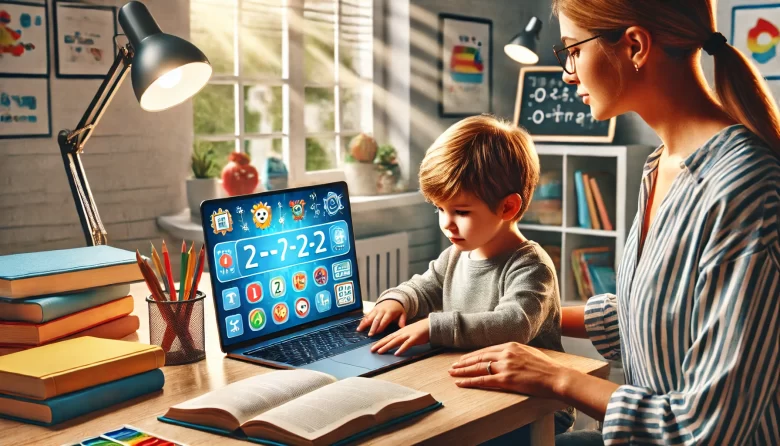Technology has transformed education, offering digital resources that enhance traditional learning. When used effectively, digital tools can reinforce classroom lessons, provide personalized learning experiences, and encourage active engagement at home.
But how can parents and educators balance technology and face-to-face learning without overwhelming children with screens?
In this comprehensive guide, we’ll cover:
✅ The benefits of integrating digital and in-person learning
✅ The best digital tools to complement classroom education
✅ Strategies for balancing tech and hands-on activities
✅ Step-by-step ideas for blended learning at home
✅ Practical tips for parents and teachers
Let’s dive in! 💻📚✨
The Benefits of Combining Digital & In-Person Learning
Blending online and offline education allows children to develop key skills while reinforcing hands-on experiences.
🔹 Why Digital Tools Enhance In-Person Learning
✅ Provides Personalized Learning – Apps adjust difficulty levels based on a child’s progress.
✅ Makes Learning More Engaging – Interactive videos, quizzes, and gamification boost motivation and retention.
✅ Supports Different Learning Styles – Visual, auditory, and kinesthetic learners benefit from multisensory experiences.
✅ Encourages Independent Exploration – Digital resources allow kids to research topics beyond the classroom.
✅ Bridges School & Home Learning – Parents can use digital tools to reinforce classroom lessons at home.
📌 Key Takeaway: When used intentionally, digital resources deepen and expand traditional learning experiences.
The Best Digital Resources to Support Learning at Home
📱 Best Educational Apps for Skill Development
| App | What It Teaches | Age Group |
|---|---|---|
| Khan Academy Kids | Reading, math, logic | 3-7 |
| Duolingo ABC | Early literacy and phonics | 4-7 |
| Prodigy Math | Gamified math learning | 6-12 |
| Endless Alphabet | Vocabulary and spelling | 3-6 |
| Toca Life World | Creativity and role-play | 4-10 |
💻 Best Websites for Home Learning
| Website | What It Offers |
|---|---|
| PBS Kids | Interactive games and videos on math, science, and reading |
| Starfall | Early reading and phonics activities |
| Scratch Jr | Coding for young learners |
| Google Arts & Culture | Virtual museum tours and historical exploration |
| Epic! | Thousands of digital books for kids |
🎮 Best Platforms for Interactive Learning
| Platform | What It Teaches |
|---|---|
| Osmo | Hands-on play with digital interaction |
| Minecraft: Education Edition | STEM and creative problem-solving |
| Kahoot! | Fun, interactive quizzes for review |
📌 Key Takeaway: Choose age-appropriate, educational resources that match your child’s interests and school curriculum.
How to Balance Digital and Hands-On Learning
A healthy balance between digital and in-person learning is key to preventing screen fatigue.
📌 The 3:1 Rule for Screen Balance
For every 1 hour of screen time, encourage at least 3 hours of:
✔ Hands-on play
✔ Outdoor exploration
✔ Reading or storytelling
✔ Social interactions
📌 Tips for Blending Digital & Hands-On Learning
✔ Pair Screen Time with Real-Life Application – If a child plays a math game, reinforce learning by counting objects around the house.
✔ Use Digital Storytelling as a Springboard for Creativity – After watching an animated story, let kids draw or act out their version.
✔ Encourage Active Learning – Instead of watching passively, have kids answer questions, discuss, or apply the concept.
✔ Set “Tech-Free” Zones – Keep mealtimes and bedtime screen-free to encourage conversation and relaxation.
📌 Key Takeaway: Technology should enhance—not replace—real-world experiences.
Step-by-Step Ideas for Blended Learning Activities
Here are five practical activities that integrate digital tools with hands-on learning:
📖 Interactive Storytelling & Book Creation (Ages 4-10)
📌 What it teaches: Language skills, creativity
🔹 Tools Needed: Epic! (for digital books) + Paper for drawing
🔹 How it Works:
- Let your child listen to a digital audiobook.
- Have them illustrate scenes from the story.
- Help them create their own handmade book inspired by the story.
🔬 Virtual Science Experiments & Real-World Exploration (Ages 5-12)
📌 What it teaches: Scientific thinking, observation skills
🔹 Tools Needed: PBS Kids Science or Mystery Science + Simple home supplies
🔹 How it Works:
- Watch a short science experiment video.
- Conduct the experiment at home (e.g., making slime, growing plants).
- Record observations using a digital journal or a physical notebook.
🎮Gamified Math Practice with Real-Life Applications (Ages 6-12)
📌 What it teaches: Logical reasoning, problem-solving
🔹 Tools Needed: Prodigy Math or Kahoot! + Physical math manipulatives (counters, coins)
🔹 How it Works:
- Solve math problems using a digital game.
- Reinforce learning by using real objects (e.g., counting coins, measuring ingredients in baking).
🗺 Virtual Travel & Cultural Exploration (Ages 6-12)
📌 What it teaches: Geography, world cultures
🔹 Tools Needed: Google Earth + Paper for journaling
🔹 How it Works:
- Explore a virtual tour of a famous location (e.g., Egyptian pyramids, the Amazon rainforest).
- Have kids draw what they saw or write a travel diary entry.
🎭Digital Music Creation & Performance (Ages 5-12)
📌 What it teaches: Rhythm, coordination, self-expression
🔹 Tools Needed: Chrome Music Lab or GarageBand
🔹 How it Works:
- Let kids compose a short song digitally.
- Encourage them to perform it using real instruments or body percussion.
📌 Key Takeaway: Blended learning should be interactive and engaging!
Practical Tips for Parents & Educators
📌 For Parents: How to Support Home Learning
✔ Use digital tools as reinforcement, not replacement – Learning apps should complement real-world learning.
✔ Encourage curiosity – If your child is interested in space, explore virtual planetariums, books, and outdoor star-gazing.
✔ Make learning social – Use video calls for virtual study groups or book clubs.
📌 For Educators: How to Use Digital Resources in the Classroom
✔ Blend technology with hands-on projects – Use interactive whiteboards alongside physical art, science, and reading activities.
✔ Assign digital extensions – Suggest educational games or videos to reinforce lessons at home.
✔ Monitor screen engagement – Ensure students are actively participating, not just watching.
Final Thoughts
✔ Digital tools should enrich, not replace, traditional learning.
✔ Choose high-quality, interactive resources that engage kids actively.
✔ Balance screen time with real-world exploration.
✔ Use technology as a bridge between classroom and home learning.
✔ Encourage curiosity, creativity, and problem-solving through blended learning approaches.
By following these strategies, parents and educators can create engaging, well-rounded learning experiences that prepare children for a tech-driven world!




